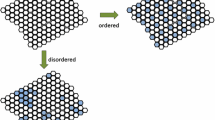Abstract
Emergent properties have been described by Mill, Lewes, Broad, Morgan and others, as novel, nonadditive, nonpredictable and nondeducible within a hierarchical context. I have developed a more definitive concept of a hierarchy that can be used to inspect the phenomenon of emergence in a new and detailed manner. A hierarchy is held together by descending constraints and new features can arise when an upper level entity restrains its components in new combinations that are not expected when viewing these components alone. Examples of emergent features are (i) matching anticodons and amino acids by aminoacetyl-tRNA synthetase enzymes appearing early among the first forms of life, (ii) negative feedback in end-product inhibition first occurring in microbes, (iii) memory in animals and (iv) apical cells in plants. Until recently, life was considered only in terms of physics and chemistry, but now it is known to have a third aspect of information that along with the descendant constraints in its hierarchical organization makes emergentism possible within a reductionist’s framework.
Similar content being viewed by others
References
S. Alexander (1920) Space,Time and Diety Macmillon London
O. Avery C.M. MacCloud M. McCarthy (1944) ArticleTitleStudies on the chemical nature of the substance inducing transformation in Pneumococcus type Transformation by a desoxyribonucleic acid fraction isolated from Pneumococcus Type III J. Exp. Med 79 137–158 Occurrence Handle1:CAS:528:DyaH2cXhtValsQ%3D%3D
W. Bechtel R.C. Richardson (1993) Discovering Complexity Princeton University Press Princeton
A. Beckermann (1992) ArticleTitleIntroduction-reductive and nonreductive physicism In: Posner R. and Meggle G. (eds), Emergence or Reduction. Walter de Gruyter, Berlin, 1 IssueID21 1–21
C.D. Broad (1923) Scientific Thought Humanities Press New York
D.T. Campbell (1974) Downward causation in hierarchically organized biological systems F.J. Ayala T. Dobzhansky (Eds) in Studies in the Philosophy of Biology University of California Press Berekely
M. Chase A. Hershey (1952) ArticleTitleIndependent functions of viral protein and nucleic acid in growth of bacteriophage J. Gen. Physiol 36 39–56 Occurrence Handle12981234
C. Darwin (1859) The Origin of the Species by Means of Natural Selection or the Preservation of Favored Races in the Struggle for Life. 1st ed only John Murray London
Dawkins R. 1986. The Blind Watchmaker. W. W. Norton, New York. 3Another valid theory besides emergentism founded on erroneous interpretation includes that of genetic mutation by Hugo deVries. His ‘mutations’ were only recessive genes pairing up in the homozygous state.
R.W. Korn (1993) ArticleTitleApical cells as meristems Acta Biotheor 41 175–185
R. Korn (1994) ArticleTitleHierarchical ordering in plant morphology Acta Biotheor 42 227–244
R. Korn (1999) ArticleTitleBiological organization – a new look at an old problem BioScience 49 51–57
R. Korn (2002) ArticleTitleBiological hierarchies, their birth, death and evolution by natural selection Biol. Philos 17 199–221
G.H. Lewes (1875) Problems of Life and Mind, Vol. 2. Trench and Turber & Co Kegan Paul
B.P. McLaughlin (1992) The rise and fall of British Emergentism R. Posner G. Meggle (Eds) Emergence or Reduction Walter de Gruyter Berlin 49–93
J.S. Mill (1843) A System of Logic, Ratiocinative and Inductive Longan and Green London
C.L. Morgan (1923) Emergent Evolution Henry Holt and Co New York
E. Nagel (1961) The Structure of Science Harcourt Brace & World
H. Pattee (1969) Physical condition for primitive functional hierarchies L.L. Whyte A.G. Wilson D. Wilson (Eds) Hierarchical Structures American Elservier Publishing Company New York
K.R. Popper J.C. Eccles (1977) The Self and its Brain Springer Berlin
H. Simon (1969) The Sciences of the Artificial The M.I.T. Press Cambridge
C. Nusslein-Volhard E. Weischaus (1980) ArticleTitleMutations a.ecting, segment number and polarity in Drosophila Nature 287 795–801 Occurrence Handle1:STN:280:Bi6D2M3jvVc%3D Occurrence Handle6776413
J.W. Valentine C.I. May (1994) ArticleTitleHierarchies in biology and paleontology Paleobiology 22 23–33
J.D. Watson F.C. Crick (1953) ArticleTitleGenetic implications of the structure of a deoxyribose nucleic acid Nature 171 964 Occurrence Handle1:CAS:528:DyaG3sXlsFWgtQ%3D%3D Occurrence Handle13063483
Wolpert (1971) ArticleTitlePositional information and pattern formation Curr. Top. Dev. Biol 6 183–224 Occurrence Handle1:STN:280:CSyB2crisVU%3D Occurrence Handle4950136
H. Yockey (1992) Information Theory and Molecular Biology Cambridge University Press Cambridge
Author information
Authors and Affiliations
Corresponding author
Rights and permissions
About this article
Cite this article
Korn, R.W. The Emergence Principle in Biological Hierarchies. Biol Philos 20, 137–151 (2005). https://doi.org/10.1007/s10539-004-4904-6
Accepted:
Issue Date:
DOI: https://doi.org/10.1007/s10539-004-4904-6




